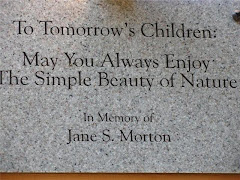The ecological impacts of this crop of lawns Americans are cultivating is incredible when one considers the pesticides and fertilizers, gasoline usage for weekly mowing, the water consumption, bagging the clippings and disposing of them…the list is endless. Further, according to Milesi, outdoor watering accounts for more than half of municipal water use in most areas, and homeowners often apply fertilizers and pesticides to their lawns at many times the recommended levels.
By the way, 128,000 square kilometers = 31,629,489 Acres...ouch! That's a lot of lawn grass. And, much of it is surrounded by pavement, cement, strip malls, etc. I know this, personally, for I have witnessed woodlands, meadows, wetlands, and family farm lands transform into sterile manscapes as a child living in Rocky River, a western suburb of Cleveland. Please read "How This Site Came To Be". As you view Milesi's map (Below), think how critical these lawn patches are to wildlife. Ask yourself, why not create wildlife-friendly spaces in each of them? It's not as if you're giving up your lawn. You're actually augmenting its value by adding entertainment and educational value to it by creating safe havens for local wildlife and migrating birds to find food, shelter, nesting spots, and water.
 Wildlife habitat loss is a serious problem faced by all of us. Urban sprawl with strip malls, factory farms and intensive farming practices, the use of pesticides, and human population growth are all leading to the destruction of animal and plant species. Here's some sobering statistics:
Wildlife habitat loss is a serious problem faced by all of us. Urban sprawl with strip malls, factory farms and intensive farming practices, the use of pesticides, and human population growth are all leading to the destruction of animal and plant species. Here's some sobering statistics:Extinction of Species
· Every 20 minutes, the world adds another 3,500 human lives but loses one or more entire species of animal or plant life - at least 27,000 species per year. (Source: PBS)
· At the present rates of extinction, as many as 20% of the world's 7-15 million species could be gone in the next 30 years. This rate of extinction has been unprecedented since the disappearance of dinosaurs 65 million years ago (Source: WWF).
The Backyard Birders Choice Website for all supplies.
Habitat Destruction (Source: Animal Alliance)
· Human population reached 1 billion by 1800. Over 6 billion by 2000. Conservative estimates predict that our population will reach 9 billion people by 2050 (Source: Population Reference Bureau).
· The hourly destruction of an estimated 240 acres of natural habitat is directly attributable to the growth in human populations.
· 80% of the decline in biological diversity is caused by habitat destruction.
We all witness fertile farm land and open fields and meadows being bought up and sub-divided into plots for housing. Fishes, amphibians, reptiles, birds, mammals, butterflies, moths and even many species of insects no longer are easy to enjoy. We may have to drive a while to enjoy them. Why not Create a Wildlife-Friendly Yard (WFY)? hopes our 25,000,000 suburban lawns can help stem the destruction of biodiversity.
Front and backyards, school yards, and business spaces can be transformed into WFY areas. The blue bird, bluejay, raccoon, opossum, boat-tailed grackle, American robin, catbird, dark-eyed junco, red-bellied woodpecker, white-breasted nuthatch, red-breasted nuthatch, house finch, goldfinch, carolin wren, common flicker, monarch butterfly, coyote, fox, eastern chipmunk, squirrel, blue and green darner dragonfly, damsel fly, screech owl, dozens of migrating warbler species, american toad, snapping turtle, frog, water beetle...I'm running out of ink...all reappeared daily or seasonally after I converted my garden and patches of sterile lawn into wildlife-friendly spaces. Here's what these species needed:
Food
Native plants provide food for wildlife. The more native plants in the landscape, the more wildlife diversity is sustained. Non-native plants support very little life. Go to article, "Going Native: Urban Wildlife Landscaping With Native Plants"- it has great videos!
Suet, cracked corn, wild bird feed mix, black-oil sunflower seeds, and thistle bird feeders were set up next to a fir tree.
I dug out a water garden- 5 feet wide, 8 feet long and 38-inches deep- then lined it with vinyl. Duck weed floats on the surface and native aquatic plants are placed in containers along the edge.
Cover
Leaves are left in the corner of the backyard, alongside the water garden and fir tree. I piled sticks and small logs, even collected small tree limbs at the city dump that had cavities in them. They were positioned to provide cover and a place to hide for rodents as well as snakes. The grass was left to grow a foot from this small space, and leaf litter was spread around it as well. A compost pile adjoins it. It's also a shaded area of the lawn where the grass doesn't grow well anyway. This small area remains moist and toads and salamanders have appeared!
Wren and woodpecker houses are set up in protected sections of the yard. Catbirds and Carolina Wrens nest in the backyard each year. Before the conversion, all these wonderful creatures were absent from the neighborhood. Wild strawberries were planted, which the catbirds enjoy. Pokeberry, which I used to dig up and throw away, is now left to grow and spread. The fruit and berry-eating birds enjoy them in the fall.
Robert Morton, M.Ed., Ed.S. writes about the natural world. Questions? Comments? Have photos, personal stories, or articles about creating wildlife-friendly spaces out of sterile manscapes? We'd enjoy publishing it on this site. Contact us on the secure Bpath Mail Form.




 <>
<>